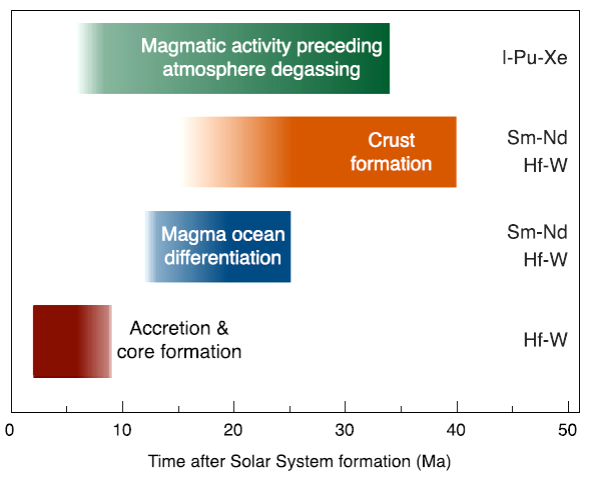Lars Borg (17-ERD-001)
Executive Summary
We are investigating the cosmochemical evidence for solar system formation and evolution from a molecular cloud. Results from our project will provide evidence regarding the theoretical model for the solar system formation, as well as provide absolute age constraints for more refined astrophysical and geophysical modeling.
Project Description
Earth sciences are predicated on the principle that geologic processes occurring in the past are the same as those occurring today. However, early solar system evolution occurring before 3.9 billion years ago involved a series of stochastic (one of a kind) events. Thus, much of our understanding of the solar system's earliest history is based on astrophysical and geophysical modeling in which future events are predicted by computer simulations. These simulations indicate that the solar system formed from a molecular cloud as a result of gravitation collapse caused by shock waves from a nearby supernova. This event produced the nascent Sun, which was surrounded by a short-lived protoplanetary disk of gas and debris. This period of solar system history lasted a few tens of thousands of years and was followed by a period of planetary accretion and differentiation that took a few tens of millions of years. In this project, we are exploring cosmochemical evidence for this theory of solar system formation and evolution, as well as refining the timescales. We intend to analyze primitive meteorite, lunar, and Martian samples for daughter products of now-extinct parent nuclides. Chemical processes occurring in the protoplanetary disk or in planetary interiors usually fractionate the parent element from the daughter element. This fractionation, combined with radioactive decay of the parent isotope, results in enrichments or deficits in the abundance of the daughter isotope relative to primitive materials that have not undergone chemical processing. These fractionation events can be dated if both the half-life and initial abundance of the parent isotope are known. By analyzing these now-extinct, short-lived isotopic systems in meteorites and samples returned from the Moon, we will test whether a supernova indeed triggered the formation of the solar system.
We expect to investigate parent isotopes that will offer insights into the formation of the solar system, based on the decay of tin-126 to tellurium-126 in approximately 20 calcium–alumina-rich meteorite inclusions. The isotope tin-126 is produced only in the ultrahigh neutron-rich environments of supernovae. If evidence for the presence of tin-126 is inferred from variations in the proportion of tellurium-126 in the inclusions, then a supernova must have contributed material to the molecular cloud within 1.3 million years of the explosion of the star. Measurements of magnesium-26 from the decay of aluminum-26 in meteorites will constrain the longevity of the protoplanetary disk. We seek to place temporal constraints on the duration over which the protoplanetary disk transformed from gas and dust into a group of planets orbiting the Sun through neodymium-142 and tungsten-182 measurements of lunar and Martian rocks. We anticipate that our results may be able to confirm the theoretical model for the solar system formation, as well as provide absolute age constraints for more refined astrophysical and geophysical modeling.
Mission Relevance
This research enhances the Laboratory's earth and atmospheric science core competency and supports the DOE science and energy objective to deliver scientific discoveries and major scientific tools that transform our understanding of nature and strengthen the connection between fundamental science advances and technological innovation.
FY17 Accomplishments and Results
In FY17 we (1) developed techniques to measure tellurium isotopic compositions of primitive meteorites; (2) completed neodymium-142 analyses on Martian meteorites at the Laboratory and tungsten-182 analyses at the University of Munster in Germany; (3) identified and separated chondrules (spheroidal mineral grains) from primitive meteorites; (4) devised ways to mount the chondrules in epoxy, measure their aluminum-magnesium ages, and analyze them for stable chromium, titanium, and magnesium isotope compositions; and (5) began age-dating several lunar crustal samples to evaluate the timing of crust formation on the Moon.
Publications and Presentations
Borg, L., 2017a. "A renewed search for short-lived Sn-126 in the early Solar System: Hydride generation MC-ICPMS for high sensitivity Te isotopic analysis." Geochimica et Cosmochimica Acta, 201: 331-344. doi: 10.1016/j.gca.2016.10.003. LLNL-JRNL-704743.
——— 2017b. "Chronologic implications for slow cooling of troctolite 76535 and temporal relationships between the Mg-suite and the ferroan anorthosite suite." Geochimica et Cosmochimica Acta, 201: 377-391. doi: 10.1016/j.gca.2016.11.021. LLNL-JRNL-660422.
——— 2017c. "The early differentiation of Mars inferred from Hf-W chronometry." Earth and Planetary Science Letters, 474: 345-354. doi: 10.1016/j.epsl.2017.06.047. LLNL-JRNL-72834.
Kruijer, T.S., et al, 2017. "The age of Jupiter inferred from the distinct genetics and formation times of meteorites." Proceedings of the National Academy of Sciences of the United States of America,114: 6712-6716. LLNL-JRNL-731226.






